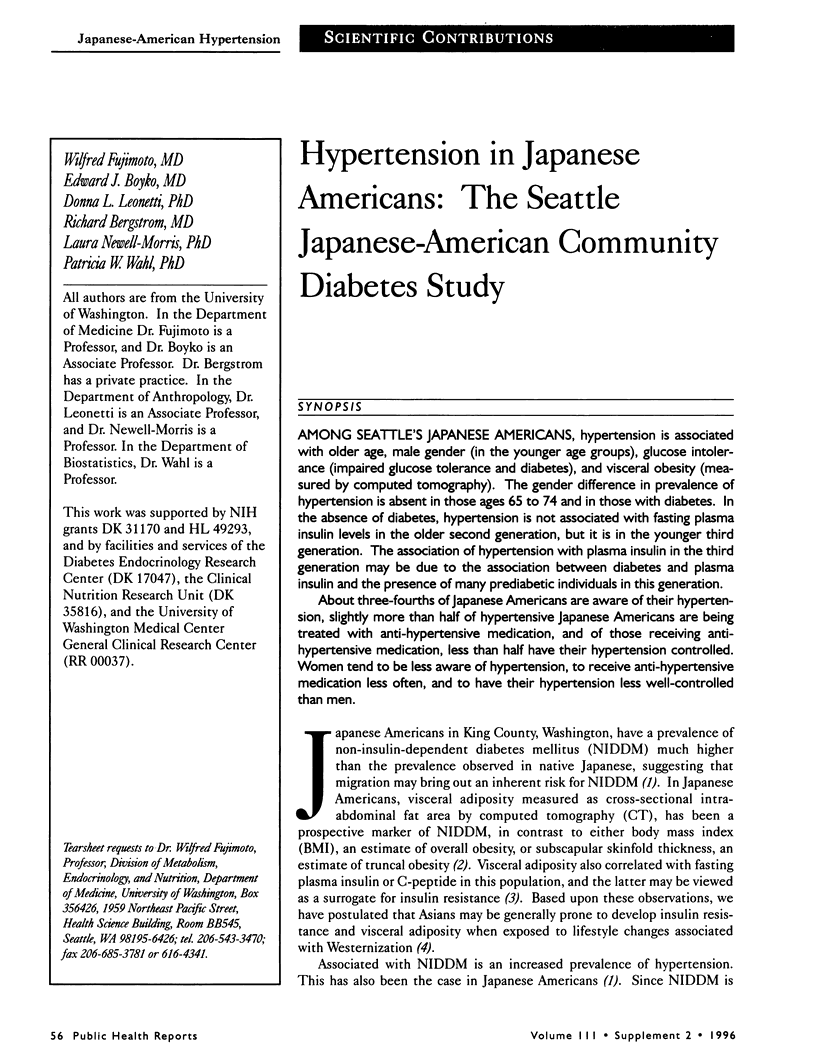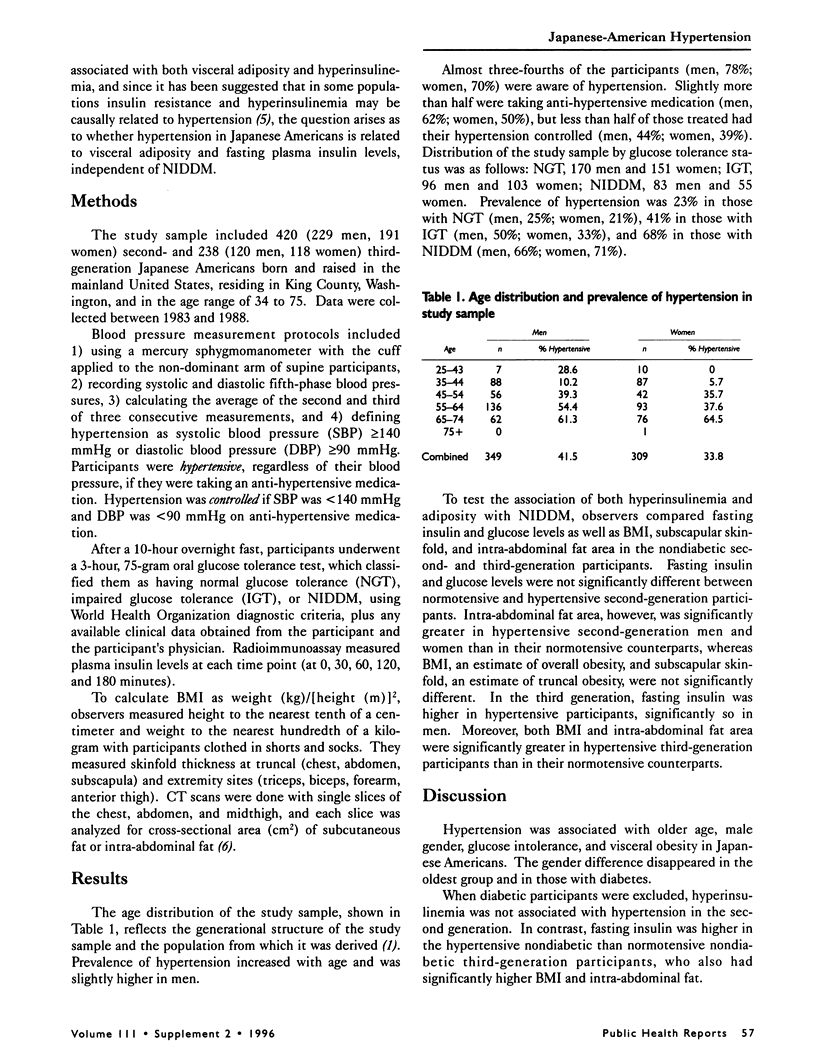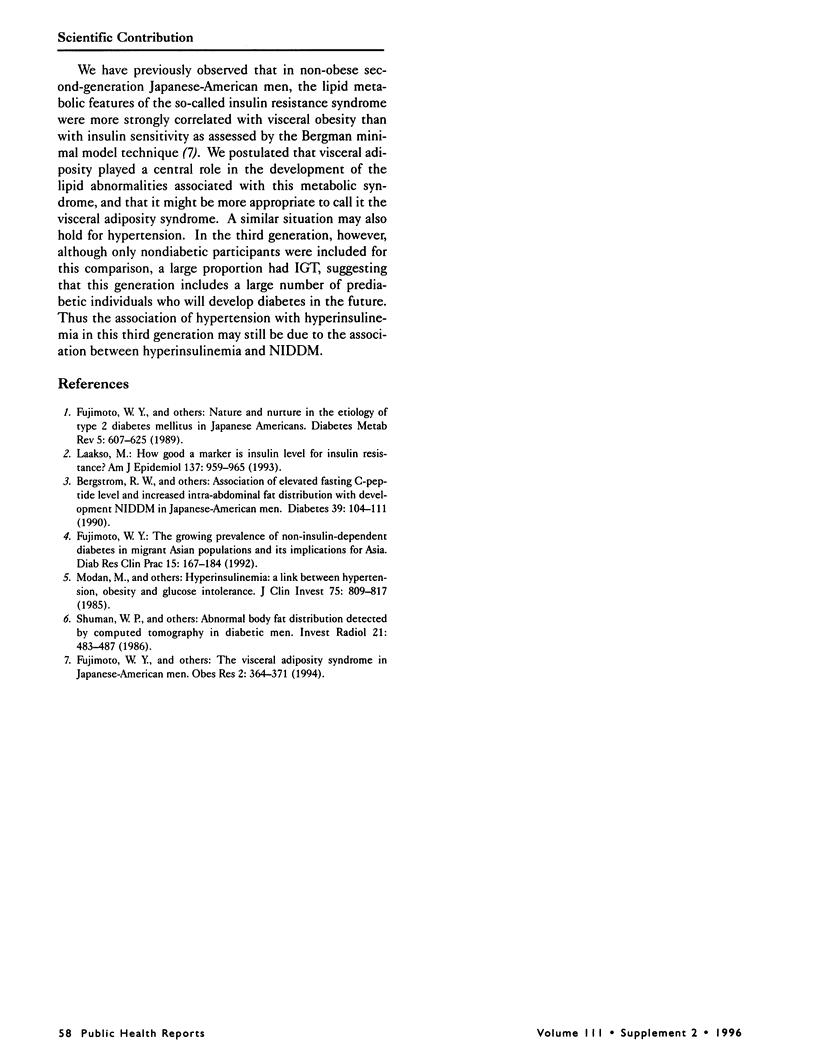Abstract
AMONG SEATTLE'S JAPANESE AMERICANS, hypertension is associated with older age, male gender (in the younger age groups), glucose intolerance (impaired glucose tolerance and diabetes), and visceral obesity (measured by computed tomography). The gender difference in prevalence of hypertension is absent in those ages 65 to 74 and in those with diabetes. In the absence of diabetes, hypertension is not associated with fasting plasma insulin levels in the older second generation, but it is in the younger third generation. The association of hypertension with plasma insulin in the third generation may be due to the association between diabetes and plasma insulin and the presence of many prediabetic individuals in this generation. About three-fourths of Japanese Americans are aware of their hypertension, slightly more than half of hypertensive Japanese Americans are being treated with anti-hypertensive medication, and of those receiving anti-hypertensive medication, less than half have their hypertension controlled. Women tend to be less aware of hypertension, to receive anti-hypertensive medication less often, and to have their hypertension less well-controlled than men.
Full text
PDF


Selected References
These references are in PubMed. This may not be the complete list of references from this article.
- Bergstrom R. W., Newell-Morris L. L., Leonetti D. L., Shuman W. P., Wahl P. W., Fujimoto W. Y. Association of elevated fasting C-peptide level and increased intra-abdominal fat distribution with development of NIDDM in Japanese-American men. Diabetes. 1990 Jan;39(1):104–111. doi: 10.2337/diacare.39.1.104. [DOI] [PubMed] [Google Scholar]
- Fujimoto W. Y., Abbate S. L., Kahn S. E., Hokanson J. E., Brunzell J. D. The visceral adiposity syndrome in Japanese-American men. Obes Res. 1994 Jul;2(4):364–371. doi: 10.1002/j.1550-8528.1994.tb00076.x. [DOI] [PubMed] [Google Scholar]
- Fujimoto W. Y., Bergstrom R. W., Newell-Morris L., Leonetti D. L. Nature and nurture in the etiology of type 2 diabetes mellitus in Japanese Americans. Diabetes Metab Rev. 1989 Nov;5(7):607–625. doi: 10.1002/dmr.5610050706. [DOI] [PubMed] [Google Scholar]
- Fujimoto W. Y. The growing prevalence of non-insulin-dependent diabetes in migrant Asian populations and its implications for Asia. Diabetes Res Clin Pract. 1992 Feb;15(2):167–183. doi: 10.1016/0168-8227(92)90022-j. [DOI] [PubMed] [Google Scholar]
- Laakso M. How good a marker is insulin level for insulin resistance? Am J Epidemiol. 1993 May 1;137(9):959–965. doi: 10.1093/oxfordjournals.aje.a116768. [DOI] [PubMed] [Google Scholar]
- Modan M., Halkin H., Almog S., Lusky A., Eshkol A., Shefi M., Shitrit A., Fuchs Z. Hyperinsulinemia. A link between hypertension obesity and glucose intolerance. J Clin Invest. 1985 Mar;75(3):809–817. doi: 10.1172/JCI111776. [DOI] [PMC free article] [PubMed] [Google Scholar]
- Shuman W. P., Morris L. L., Leonetti D. L., Wahl P. W., Moceri V. M., Moss A. A., Fujimoto W. Y. Abnormal body fat distribution detected by computed tomography in diabetic men. Invest Radiol. 1986 Jun;21(6):483–487. doi: 10.1097/00004424-198606000-00007. [DOI] [PubMed] [Google Scholar]


